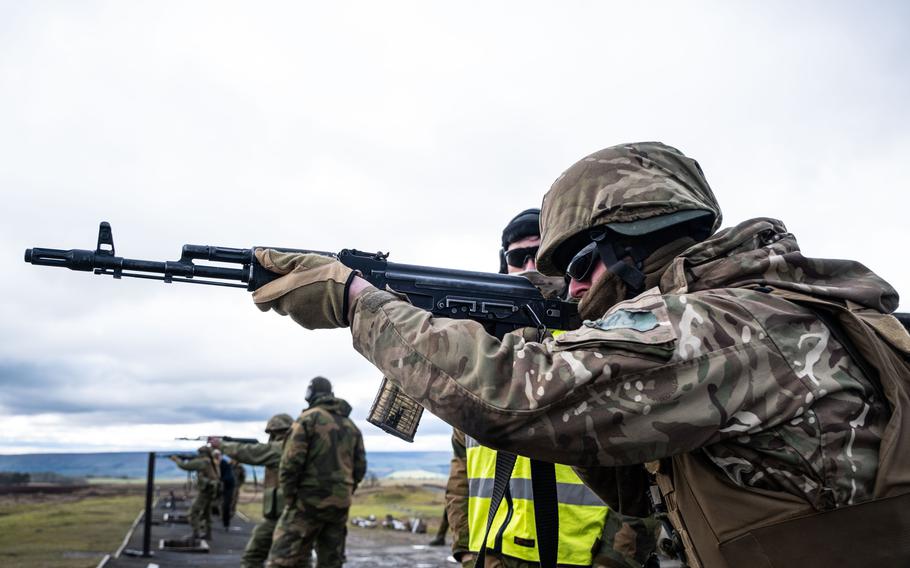
A Ukrainian soldier fires a rifle under the supervision of a Norwegian army instructor during training of Ukrainian recruits by NATO allies in the United Kingdom in March 2023. NATO this week will agree to a plan that will put the alliance in charge of efforts to arm and train the Ukrainian military, marking a shift away from an effort that so far has been an American-led endeavor. (NATO)
The U.S. and its allies will agree this week to a plan to put NATO in charge of efforts to arm and train the Ukrainian military, marking a shift away from what so far has been an American-led endeavor.
NATO Secretary-General Jens Stoltenberg, speaking before the start Thursday of a two-day ministerial conference, said defense chiefs are gathered in Brussels to put the finishing touches on a concept expected to be met with final approval at NATO’s July summit in Washington.
“What I can say today is that we now have very broad agreement … that NATO takes a leading role in the coordination of security assistance and training,” Stoltenberg said.
In recent months, there has been a push at NATO headquarters to take control of the initiative, which was launched by the Pentagon in the aftermath of Russia’s full-scale invasion of Ukraine in February 2022.
It’s not clear whether the NATO-led effort will mean the dissolution of Defense Secretary Lloyd Austin’s Ukraine Defense Contact Group, also known as the Ramstein Group, which is meeting at NATO headquarters this week.
Austin, speaking Thursday after the 23rd meeting of his group, gave no sign that the Ramstein format would be ending anytime soon. Austin also said the new influx of Western arms has helped Ukraine blunt some of Russia’s recent gains inside the country.
“We remain determined to keep supporting Ukraine while ensuring our own military readiness at this challenging moment,” Austin said.
Meanwhile, the new NATO plan will have implications for the U.S.-led initiative at the Army’s Europe headquarters in Wiesbaden, Germany, which has been the focal point of efforts to equip Ukraine.
The Security Assistance Group for Ukraine, known as the SAG-U, has been under American command since it was launched in 2022 at U.S. European Command headquarters in Stuttgart.
It later moved to Wiesbaden, remaining under the leadership of EUCOM’s Gen. Christopher Cavoli. While Cavoli would still be in charge, it would be in his capacity as NATO’s top military commander rather than his EUCOM role, Stoltenberg said.
Using NATO’s command structure will generate “a more robust, more predictable framework” for supporting Ukraine, Stoltenberg said.
The idea of putting NATO in charge emerged in April when Stoltenberg floated the idea at an alliance ministerial meeting. At the time, Washington was at a partisan impasse on defense spending, with lawmakers at odds about future support for arming Ukraine.
The situation raised concerns about the reliability of American backing for Ukraine and also sparked interest inside NATO about taking on a larger role.
“We of course appreciate what the United States and other allies have done. It’s unprecedented,” Stoltenberg said. “At the same time, we saw that the United States spent six months agreeing (on) a supplemental for Ukraine.”
Likewise, allies in Europe have made promises on weapons shipments that have not been delivered, he said.
“If we turn this into not voluntary contributions but NATO commitments, of course it will become more robust, it will become more reliable,” Stoltenberg said.
Since Russia’s full-scale invasion, allies have provided about $43 billion in military support to Ukraine each year, Stoltenberg said.
In Brussels, defense leaders are meeting for the final time before the heads of state of member countries convene in Washington next month.
In addition to final approval on NATO’s larger role in supporting Ukraine, allies also are expected to come to agreement on a long-term funding plan for Ukraine.
At an April foreign ministers’ meeting, a $100 billion fund was under consideration, but the final figure hasn’t been finalized.
While Ukraine will be a focal point of the Washington summit in July, Kyiv’s aim of being welcomed into the alliance as an official member is off the table for now.
Still, allies will agree to “strong language” on Ukraine’s eventual membership, Stoltenberg said.
“It’s not for me to go into the details on the exact wording, but I expect that that language will be even clearer in our commitment that Ukraine will become a member of the alliance,” Stoltenberg said.